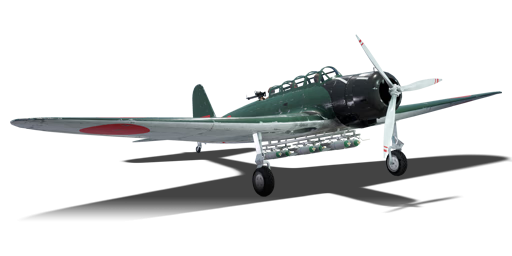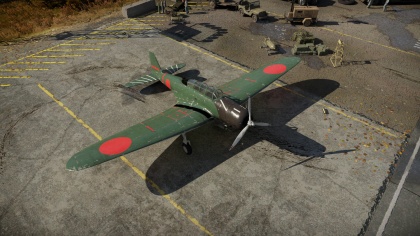B5N2
Contents
Description
The B5N2 is a rank I Japanese naval bomber
with a battle rating of 1.0 (AB), 1.3 (RB), and 1.7 (SB). This aircraft has been in the game since the start of the Open Beta Test in Update 1.27.
The Allied reporting name for this aircraft was "Kate".
General info
Flight Performance
| Characteristics | |||||||
|---|---|---|---|---|---|---|---|
| Stock | |||||||
| Max Speed (km/h at 3,600 m) |
Max altitude (meters) |
Turn time (seconds) |
Rate of climb (meters/second) |
Take-off run (meters) | |||
| AB | RB | AB | RB | AB | RB | ||
| 361 | 348 | 8260 | 20.3 | 20.6 | 2.6 | 4.0 | 270 |
| Upgraded | |||||||
| Max Speed (km/h at 3,600 m) |
Max altitude (meters) | Turn time (seconds) | Rate of climb (meters/second) |
Take-off run (meters) | |||
| AB | RB | AB | RB | AB | RB | ||
| 400 | 378 | 8260 | 18.6 | 19.4 | 12.1 | 6.5 | 270 |
Details
| Features | ||||
|---|---|---|---|---|
| Combat flap | Take-off flap | Landing flap | Air brakes | Arrestor gear |
| ✓ | ✓ | ✓ | X | X |
| Limits | ||||
|---|---|---|---|---|
| Wing-break speed (km/h) |
Gear limit (km/h) |
Combat flap (km/h) |
Max Static G | |
| + | - | |||
| 555 | 450 | 420 | ~11 | ~4 |
| Optimal velocities | |||
|---|---|---|---|
| Ailerons (km/h) |
Rudder (km/h) |
Elevators (km/h) |
Radiator (km/h) |
| < 320 | < 320 | < 350 | > 210 |
| Compressor (RB/SB) | ||
|---|---|---|
| Setting 1 | ||
| Optimal altitude | 100% Engine power | WEP Engine power |
| 2,500 m | 950 hp | 1,081 hp |
Survivability and armour
- No armour
- Non-self-sealing fuel tanks (2 in each wing)
Armaments
Suspended armament
The B5N2 can be outfitted with the following ordnance:
- 6 x 60 kg Navy Type 97 Number 6 ground bombs (360 kg total)
- 2 x 250 kg Navy Type Number 25 Model 2 bombs (500 kg total)
- 2 x 250 kg Type 98 bombs (500 kg total)
- 1 x 800 kg Navy Type Number 80 Model 1 bomb (800 kg total)
- 1 x 800 kg Navy Type 99 Number 80 AP bomb (800 kg total)
- 1 x Type 91 Mod.2 torpedo
- 1 x Type 91 Mod.3 torpedo
Defensive armament
The B5N2 is defended by:
- 1 x 7.7 mm Type 92 machine gun, dorsal gun turret (1,000 rpg)
Usage in battles
B5N2 is a Japanese torpedo-bomber that is lacking in offensive armarments but is defend by a single Type 92 (7.7 mm) machinegun at the back, Which makes it lacking in defence against enemy pursuers. Its greatest weapon is not the speed to outrun enemy fighters but its manueverbility and ability to do tight turns against most enemy aircrafts till help arrives from the team.
The B5N2 might lacking in offensive weaponary such as machineguns and cannons but it got a great variety of payload from 60kg bombs to 800kg bombs even torpedos in its aresenal to take out ground and naval targets with. Coming with 2 different 800kg bombs its important to pick the right one for the task the B5N2 is about to do, preferably the Navy Type Number 80 Model 1 over the Navy Type 99 Number 80 AP, with the benefit that the Type Number 80 Model 1 got better blast radius and explosive power than the Type 99 Number 80 AP bomb which is good at taking out a single heavily armored target. But can also come with two different sets of 250kg bombs that can be dropped one by one and is preferable when striking at two different targets than a singular 800kg.
Naval targets its most prefered to use the Type 91 Mod.2 and Type 91 Mod.3 to deal with the sailors, keep in mind to dive and get fast speed to quickly get in and out of engagement with a warship or patrolboat to minimize the risk of being shot down. But when doing a dive attack to get the speed its important to not go over the speed limit where the B5N2 can drop the torpedos without having them explode in the water on contact which would make the attack futile.
Enemies to be aware of is mostly everything lacking in firepower and defensive guns the B5N2 is one of the easy preys for enemy fighters even for some enemy bombers the B5N2 will be an easy target to attack on with minimal resistance. The defensive gunner does have adequate room to aim its gun with and protect the B5N2 only con with it is the lacking of firepower to actually do damage, but at 1.7 it can be enough to defend itself against biplanes and early fighters with little to no protection.
Manual Engine Control
| MEC elements | ||||||
|---|---|---|---|---|---|---|
| Mixer | Pitch | Radiator | Supercharger | Turbocharger | ||
| Oil | Water | Type | ||||
| Controllable | Not controllable | Not controllable | Not controllable | Separate | Not controllable | Not controllable |
Modules
| Tier | Flight performance | Survivability | Weaponry | ||
|---|---|---|---|---|---|
| I | Fuselage repair | Radiator | 17 3/4 in (mod45) | ||
| II | Compressor | Airframe | Turret 7 mm | Improved torpedo | |
| III | Wings repair | Engine | 12 in (mod30) | ||
| IV | Engine injection | Cover | New 7 mm MGs (Turret) | 14 in (mod35) | |
- When upgrading this plane focus on getting the payload especially the torpedo modification. This is due to the high chance Japan has to get naval maps.
Pros and cons
Pros:
- Fast and manoeuvrable (powered by Nakajima Sakae 11 14 Cylinder Radial, the same engine in the A6M)
- Excellent elevator and rudder authority
- Wide variety of bombs and torpedoes + bombsight for any kind of situation
Cons:
- Poor roll rate
- No offensive armament
- Weak defensive armament (only one 7.7 mm machine gun)
- No armour or bulletproof glass to protect the pilot or crew
- Tremendous fuel load means this plane is prone to fuel tank fires especially any hits to the wing roots (where the fuel tanks are located)
History
The Nakajima B5N2 (Allied code name: Kate) was a plane first flown in January 1937 for the Imperial Japanese Navy. About ~1149 Nakajima B5N Torpedo bombers were made for the Japanese Navy. It would see service in World war 2 and was the Japanese Navy's primary torpedo bomber for the early part of World war 2. The Nakajima B5N Torpedo bomber was credited with the sinking of three US Carriers the USS Lexington CV-2, USS Yorktown CV-6 and USS Hornet CV-8. One of the most notable pilot of the B5N is Mitsuo Fuchida, who led the first wave of aircraft during the Japanese attack on Pearl Harbor.
Although a total of 5,928 B5Ns were built, none survived the war. Two B5N's are know to exist, both made from wreckage's. One can be seen at the Pearl Harbor Memorial, it is missing it's tail, left wing, engine, canopy, and a few other parts.
In-game description
Before the advent of the B5N, Japan used the B2M and B4Y as torpedo biplanes. However, the significant limitations of biplanes were obvious, so in 1935, inspired by the monoplane A5M fighter, the Imperial Japanese Navy developed the 10-Shi torpedo bomber specification.
Nakajima and Mitsubishi participated in the competition. Nakajima decided to incorporate many new ideas in their B5N design. The prototype had a hydraulic wing-folding system so that the plane could be stored on an aircraft carrier, and Fowler flaps were used to improve stability while landing. In addition, the B5N had a hydraulic retractable landing gear system.
Although Mitsubishi also received an order for production of its own B5M torpedo bomber, the Nakajima model won the contest and in 1937 was accepted as a production model carrier-based torpedo bomber.
To create a production model, however, some changes had to be made in the prototype’s design. The wing-folding system was changed to a manual one, and the flaps were replaced with conventional ones.
In 1939, the B5N2 was developed. It differed from its predecessor in its more powerful and reliable Sakae engine, which produced 1000 hp instead of the Hikari 3’s 770.
At the beginning of World War II, the B5N torpedo series had no worthy competitors among Allied aircraft and made a great showing in the attack on Pearl Harbor, as well as in subsequent operations, where B5N forces sank four U.S. aircraft carriers within one year.
A total of 5,928 B5Ns were built.
Media
Excellent additions to the article would be video guides, screenshots from the game, and photos.
See also
Links to the articles on the War Thunder Wiki that you think will be useful for the reader, for example:
- reference to the series of the aircraft;
- links to approximate analogues of other nations and research trees.
External links
Paste links to sources and external resources, such as:
- topic on the official game forum;
- encyclopedia page on the aircraft;
- other literature.
| Nakajima Aircraft Company (中島飛行機株式会社 ) | |
|---|---|
| Fighters | Ki-27 otsu · Ki-27 otsu Tachiarai |
| Ki-43-I · Ki-43-II · Ki-43-III otsu | |
| Ki-44-I · Ki-44-I 34 · Ki-44-II otsu · Ki-44-II hei | |
| Ki-84 ko · Ki-84 otsu · Ki-84 hei | |
| Ki-87 | |
| Hydroplanes | A6M2-N* |
| Interceptors | J1N1 · J5N1 |
| Bombers | B5N2 |
| B6N1 Model 11 · B6N2 Model 12 · B6N2a Model 12Ko | |
| G5N1 · G8N1 | |
| Ki-49-I · Ki-49-IIa · Ki-49-IIb · Ki-49-IIb/L | |
| Recon | E8N2 |
| Jet Fighters | Kikka |
| Captured | ␗Ki-27 otsu · ▃Ki-43-II · ␗Ki-43-III ko · ␗Ki-44-II hei · ␗Ki-84 ko |
| *Refit of the Mitsubishi A6M2 mod. 11 | |
| See also | Fuji Heavy Industries (1957-2017) |
| Japan bombers | |
|---|---|
| Navy | |
| Carrier-based attack bomber | |
| B5N | B5N2 |
| B6N | B6N1 · B6N2 · B6N2a |
| B7A | B7A2 · B7A2 (Homare 23) |
| Carrier-based dive bomber | |
| D3A | D3A1 |
| D4Y | D4Y1 · D4Y2 · D4Y3 Ko |
| Shipboard Observation seaplane | |
| F1M | F1M2 |
| Land-based Attack bomber | |
| G4M | G4M1 |
| G5N | G5N1 |
| G8N | G8N1 |
| Flying boat | |
| H6K | H6K4 |
| H8K | H8K2 · H8K3 |
| Land-based Bomber | |
| P1Y | P1Y1 |
| Army | |
| Light | Ki-32 |
| Ki-48-II otsu | |
| Heavy | Ki-21-Ia · Ki-21-I hei |
| Ki-49-I · Ki-49-IIa · Ki-49-IIb · Ki-49-IIb/L | |
| Ki-67-I Ko · Ki-67-I otsu | |
| Other countries | ▅B-17E |





